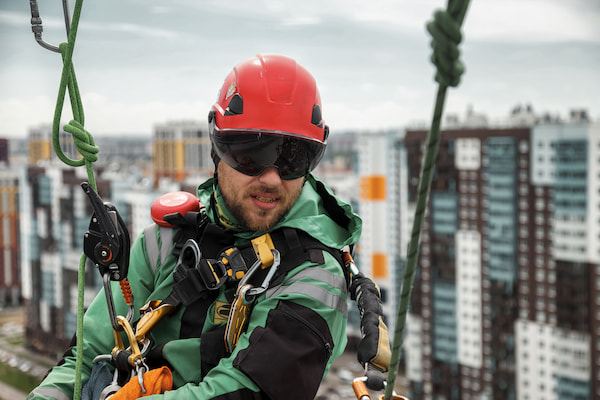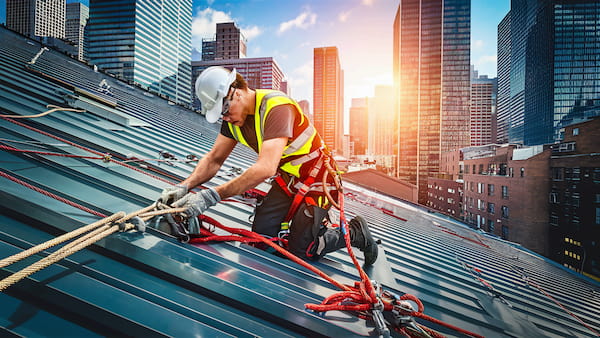Top 6 Fall Protection Mistakes To Avoid
Posted by Howie Scarboro - CEO Fall Protection Distributors, LLC on May 17th 2024
The 6 Most Common Mistakes Contractors Make When Using Fall Protection
Falls remain one of the leading causes of injuries and fatalities in the roofing and construction industry. According to the Occupational Safety and Health Administration (OSHA), falls account for nearly 40% of all deaths in the construction sector each year. In 2022 alone, there were 5,200 worker injuries; tragically, 900 of those were fatalities.
These staggering statistics underscore the critical importance of fall protection, safety training, and proper equipment. Understanding and addressing contractors' common mistakes in fall protection can significantly reduce these numbers, ensuring a safer work environment for everyone involved.
Adequate fall protection is crucial for workplace safety, especially in construction. Despite its importance, contractors often make critical mistakes that can lead to severe accidents and injuries.
Let's explore several of the most common fall protection mistakes and how to avoid them.
1. Inadequate Fall Protection Training for Workers
One of the most critical mistakes is inadequate worker training. OSHA requires workers to recognize fall hazards and adequately use fall protection equipment. Without the necessary training, workers may find that even the best equipment fails to be effective.

Safety Training Is Crucial
This one is an easy fix; there are no shortcuts to proper safety training for your employees. All workers must be trained and equipped for the job at hand. Schedule comprehensive training and safety stand-down sessions to keep your crew up-to-date on the latest safety protocols. Hands-on training is superior to classroom learning for this type of information.
2. Improper Use of Fall Protection Equipment
Even with proper training, misuse of fall protection equipment is a common issue. Workers might wear harnesses incorrectly or use lanyards with incorrect lengths, negating the equipment's benefits.
Workers Must Use Fall Protection Equipment Properly
Workers are to use the correct equipment for a specific task. They should not modify equipment or use it for anything other than its intended purpose. Equipment users can actively avoid errors by thoroughly reading and understanding the manufacturer's instructions for the equipment they use. Lost instructions can be easily replaced by the manufacturer or downloaded online.
3. Failure to Develop and Implement a Fall Protection Plan
All projects start with a comprehensive fall protection plan, which is essential for any work site with a risk of falls. Unfortunately, many contractors neglect this step, leading to inefficient work methods and an increased risk of falls.

Do Not Begin Work Without A Plan
The Project Manager or Safety Manager must develop a detailed fall protection plan specific to the work. As the project progresses, the Plan's vital parts —hazard assessments, equipment needs, and rescue procedures—must be reviewed and updated regularly.
4. Overlooking the Importance of Guardrails and Safety Nets
Every project is different, and there are numerous strategies to mitigate the risk of worker injuries. Some of the most overlooked and improperly used products are Guardrails and Safety Nets. You most commonly see guardrails on commercial roofs around all open edges and floor openings. Use safety nets where guardrails are not feasible. Consider using these safety tools for larger projects with low-slope roofs, but ensure that guardrails and nets meet OSHA standards.
5. Neglecting Safety Equipment Maintenance and Inspections
Safety Managers and employees should regularly inspect all equipment and maintain a logbook for future reference. Neglecting this can lead to equipment failure at critical moments.
A Safety Culture Begins with Fall Protection Equipment Inspections
Implement a strict inspection schedule for all fall protection equipment and immediately repair or replace damaged equipment. Keep detailed records of inspections and maintenance activities for future reference. Numerous software programs are available to help organize and schedule equipment inspections.

6. Ignoring the Need for Rescue Plans
All job sites with a risk of falling from heights must have an OSHA-compliant Rescue Plan in place. Brief workers on the Plan and ensure everyone understands their role in the event of an accident. Many contractors either need a rescue plan or have one that is well-communicated to the workers. The time it takes to rescue a worker can be the critical factor that determines whether they sustain minor injuries or face a fatal outcome.
Rescue Plans Save Lives
When developing job site fall protection plans, employers must include an OSHA-compliant Rescue Plan that concisely explains how to rescue a fallen worker. They must also train workers on rescue procedures and ensure they know their roles. Finally, they must conduct regular drills to prepare workers to deal with emergencies.
Conclusion
Adequate fall protection is essential to ensure the safety of workers in construction and other high-risk industries. By avoiding these common mistakes—providing sufficient training, using equipment properly, developing thorough fall protection and rescue plans, and maintaining equipment—contractors can significantly reduce the risk of falls and create a safer work environment. Prioritizing these elements ensures compliance with OSHA standards and fosters a safety culture that protects workers and improves productivity.
Call 863-703-4522 to discuss your project, or visit www.StandingSeamRoofAnchor.com. Learn more about fall protection by reading our OSHA's 48-page manual.

